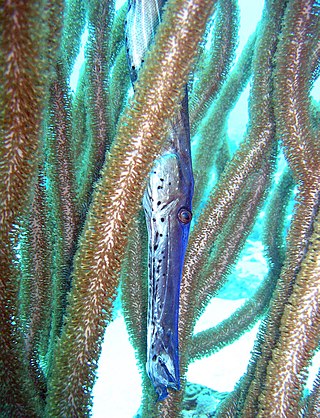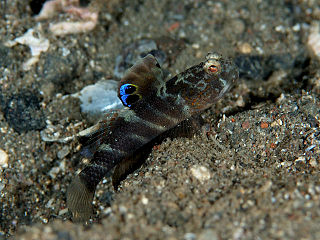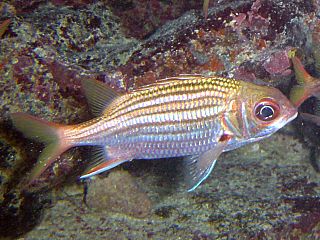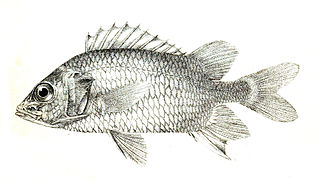
Aulostomus maculatus, the West Atlantic trumpetfish, is a long-bodied fish with an upturned mouth. It often swims vertically while trying to blend with vertical coral, such as sea rods, sea pens, and pipe sponges.

Nemateleotris magnifica, known by a variety of common names including fire goby, magnificent fire fish, fire dartfish, or red fire goby, is a species of dartfish native to coral reefs of the Indian and Pacific oceans.

Ptereleotris evides, the Blackfin dartfish or scissortail goby, is a species of dartfish native to the Indian Ocean and the western Pacific Ocean. It is a reef inhabitant and can be found at depths of from 2 to 15 metres. This species can reach a length of 14 centimetres (5.5 in) TL. It can also be found in the aquarium trade.

Parupeneus multifasciatus, the manybar goatfish, is a species of goatfish native to the eastern Indian Ocean Pacific Ocean where it is found from Christmas Island to the Hawaiian Islands and from southern Japan to Lord Howe Island.

Mahidolia mystacina, the flagfin prawn goby, flagfin shrimpgoby or smiling goby, is a species of goby native to the Indian Ocean and the Pacific Ocean from Delagoa Bay, Mozambique to the Society Islands and from southern Japan to Samoa and northern Australia. This species occurs in marine and brackish waters, being found in coastal bays, estuaries and reef bases where the bottom is silty or muddy at depths of from 5 to 25 metres. This species is a commensal with a species of alpheid shrimp, using its burrow as its home. This species can reach a length of 8 centimetres (3.1 in) TL. This species can also be found in the aquarium trade. It is currently the only known member of its genus.

Oxyurichthys microlepis, commonly known as the maned goby, is a species of goby native to tropical marine and brackish waters along the coasts of the Indian Ocean from Africa to the western Pacific Ocean where it occurs in estuaries and inshore waters to depths of about 75 metres (246 ft). It occurs in the Mekong Delta and is suspected to use the tidal flow up the river to reach as far inland as Cambodia. This species can reach a length of 13.5 centimetres (5.3 in) TL. It is of minor importance to local commercial fisheries and can also be found in the aquarium trade.

The longspine squirrelfish is a silvery red, sea fish with orange-gold body stripes. One of about 150 species of squirrelfish, their most distinguishing characteristics are their large eyes and the long third spine of the anal fin. It is often included in public aquarium displays. The length of the longspine squirrelfish is about 18 cm. It lives in coral reefs in tropical and warm temperate seas and eats zoobenthos. It is territorial and uses sounds called "grunts" and "staccatos" to defend its crevice, warn of danger and, in groups, intimidate predators such as the moray eel. The longspine squirrelfish is edible and harvested on a small scale.

Myripristis adusta, common name shadowfin soldierfish, is a species of soldierfish belonging to the family Holocentridae.

Holocentrus adscensionis is a squirrelfish of the family Holocentridae found in the Atlantic Ocean. Its range extends from North Carolina, USA to Brazil and throughout the Caribbean Sea in the Western Atlantic and from Gabon to Ascension Island in the Eastern Atlantic. A single records were reported in 2016 from the central Mediterranean Sea off Malta and in 2023 from the Mediterranean Sea near Northern Cyprus.

Myripristis botche, the blacktip soldierfish, splendid soldierfish, or splendid squirrelfish, is a species of soldierfish belonging to the family Holocentridae.
The comb goby is a species of goby native to marine and brackish waters of the Indian Ocean and the western Pacific Ocean. This species occurs mostly on muddy substrates near mangrove forests. This species grows to a length of 18 centimetres (7.1 in) TL. This species is of minor importance to local commercial fisheries and can also be found in the aquarium trade. This species is the only known member of its genus. Paratrypauchen microcephalus has been recorded from areas which have soft, muddy bottoms, in estuaries and around the mouths of rivers near mangroves where they inhabit deep burrows in the mud. It is not known if they excavate the burrows themselves. This species feeds on benthic invertebrates such as crustaceans.

The redstripe pipefish is a fish from the genus Dunckerocampus.

Neoniphon opercularis, the blackfin squirrelfish, also known as the mouth-fin squirrelfish or clearfin squirrelfish, is a species of squirrelfish found in the Indian Ocean and Pacific Ocean from East Africa as far east as New Caledonia. It lives alone or in small groups in or near reefs and lagoons between 3 and 25 metres deep and can reach sizes of up to 35.0 centimetres (13.8 in) TL. It eats crabs and shrimps. Its dorsal fin is raised to scare off or startle predators. It also has a large venomous spine at the corner of its preopercle. It is relatively unaffected by commercial fishing, but is sometimes used as bait for tuna fisheries.

Neoniphon marianus, also known as the longjaw squirrelfish, is a species of squirrelfish found in the Western Atlantic Ocean from the Florida Keys south to Trinidad and throughout the Caribbean Sea. It lives near reefs at depths between 1 and 70 metres, usually between 30 and 60 metres, and can reach sizes of up to 18.0 centimetres (7.1 in) TL. It is nocturnal and consumes mostly shrimps, but will also eat crabs.

Sargocentron caudimaculatum, the silverspot squirrelfish or whitetail squirrelfish, is a reef-associated member of the family Holocentridae. It is native to the Indian and Pacific Oceans from East Africa to Japan and northern Australia and as far east as the Marshall Islands. It lives near reefs, but can also be found in lagoons and drop-offs at depths between 2 and 40 metres. It is a nocturnal predator, feeding primarily on crabs and shrimps. It can reach sizes of up to 25.0 centimetres (9.8 in) TL. Although it is caught commercially and can be found in the aquarium trade, there are no known major threats to this species.

Sargocentron coruscum, more commonly known as the reef squirrelfish, is a member of the family Holocentridae native to the western Atlantic Ocean from Florida, USA to northern South America. It lives over sandy and rocky substrates, as well as coral reefs, generally between 1 and 30 metres deep. It is a nocturnal predator, feeding primarily on shrimps, but will also eat crabs. It searches for food alone or in small schools. It can reach sizes of up to 15.0 centimetres (5.9 in) TL. When alarmed, it will hide in crevices between corals.

Sargocentron dorsomaculatum, also known as the spotfin squirrelfish, is a species of squirrelfish found in the western Pacific Ocean near the Ryukyu Islands, Pohnpei, Kosrae, the Caroline Islands, and Palau. It lives in shallow reefs at depths between 2 and 9 metres. Like other members of its genus, it is nocturnal and seeks shelter among corals and other structures. It can reach sizes of up to 19.7 centimetres (7.8 in) SL.

Sargocentron ensifer, or the yellow-striped squirrelfish, is a member of the family Holocentridae. It is native to the Pacific Ocean from southern Japan to New Caledonia, Hawaii and the Pitcairn Islands. It lives in deep reefs at depths between 0 and 64 metres, hiding in crevices by day and foraging for food by night. It feeds on small fishes and crustaceans and can reach sizes of up to 23.0 centimetres (9.1 in) SL, though a length of 15.0 centimetres (5.9 in) TL is more common.

Neoniphon argenteus, the clearfin squirrelfish or silver squirrelfish, is a seldom-seen member of the family Holocentridae. It is native to the Indian Ocean and Pacific Ocean from East Africa to New Caledonia. It is also found both north and south of Australia and throughout Micronesia. It lives mainly around islands and shallow reefs, and like N. sammara is associated with Acropora corals. Its depth range is 3–20 m (9.8–65.6 ft) and it can reach sizes of up to 24.0 cm (9.4 in) TL. It feeds primarily on benthic invertebrates. It is found in the ornamental trade and can be used as bait in tuna fisheries, but there are currently no known major threats to the species.

Neoniphon aurolineatus, more commonly known as the yellowstriped squirrelfish or gold-lined squirrelfish, is a member of the family Holocentridae. It has a wide range throughout the Indian and Pacific Oceans stretching east from Mauritius to Hawaii and south from Japan to the Great Barrier Reef of Australia. It lives on the outer reef slopes at depths between 30 and 188 metres. It lives near the ocean floor or in caves, generally staying alone or in small groups. It feeds on crustaceans and can reach sizes of up to 25.0 centimetres (9.8 in) TL. It is listed as "Least Concern" by the IUCN due to its deep-water habitat and lack of known major threats.




















